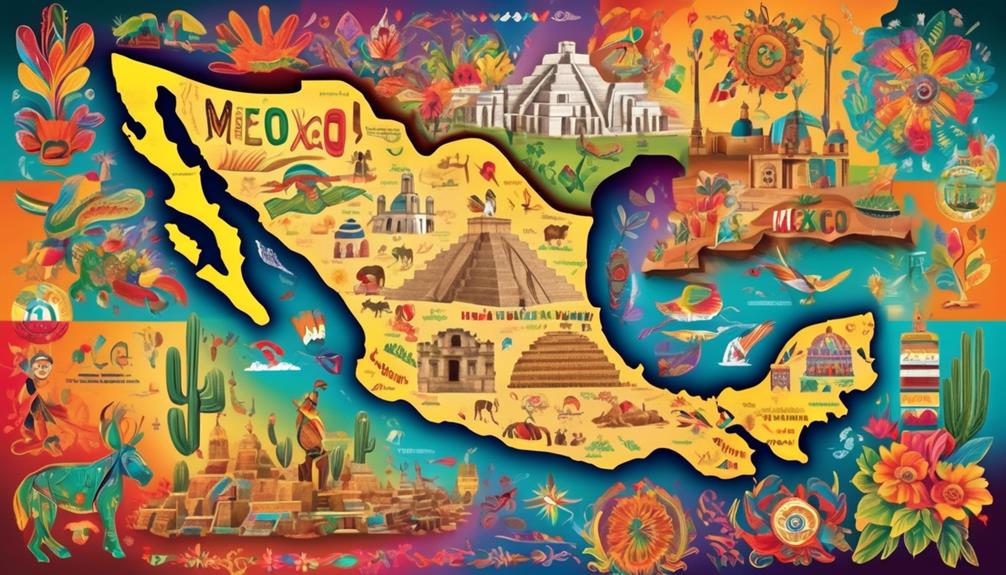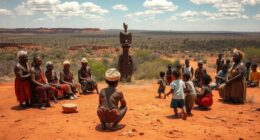It is incredible that in a country as diverse as Mexico, the multitude of indigenous languages spoken reflects the profound cultural heritage of the nation.
But have you ever wondered just how many indigenous languages are actually spoken in Mexico? The answer might surprise you.
As we explore this topic, we'll uncover the significance of these languages, the challenges they face, and the efforts being made to preserve them.
Stay tuned to discover the fascinating world of indigenous languages in Mexico and their future in an ever-changing society.
Key Takeaways
- There are over 68 indigenous languages recognized as national languages in Mexico.
- Indigenous languages in Mexico have over 364 linguistic variants.
- Indigenous languages preserve cultural practices, beliefs, and values.
- Approximately 64% of indigenous languages in Mexico are at risk of extinction.
The Diversity of Indigenous Languages
The linguistic landscape of Mexico is characterized by a rich tapestry of indigenous languages, reflecting the diverse cultural heritage of the country's indigenous communities. The sheer number of indigenous languages spoken in Mexico is astounding, with over 68 languages recognized as national languages and over 364 linguistic variants within these languages. This linguistic diversity is a testament to the cultural preservation efforts of Mexico's indigenous communities, who've safeguarded their ancestral languages against the pressures of globalization and dominant languages.
Each indigenous language in Mexico encapsulates a unique worldview, with its own grammatical structures, phonetics, and lexicon. This linguistic diversity fosters a profound sense of cultural identity and belonging among indigenous communities. Moreover, these languages serve as repositories of traditional knowledge, encompassing indigenous wisdom, ecological insights, and historical narratives that are crucial for understanding Mexico's rich cultural tapestry.
Comparatively, the linguistic diversity in Mexico surpasses that of many other countries, underscoring the nation's commitment to safeguarding and promoting its indigenous languages. The government, scholars, and indigenous communities collaborate to preserve and revitalize these languages, recognizing their intrinsic value as part of Mexico's cultural heritage.
The Significance of Indigenous Languages

Indigenous languages in Mexico play a pivotal role in preserving cultural heritage and transmitting traditional knowledge across generations. The significance of these languages extends far beyond mere communication; it's intertwined with the very essence of indigenous communities.
Consider the following points:
- Cultural Preservation: Indigenous languages are repositories of unique cultural practices, beliefs, and values, essential for preserving the identity and heritage of indigenous peoples. The nuances of language often encapsulate societal norms, rituals, and historical narratives that are integral to understanding and upholding indigenous cultures.
- Linguistic Heritage: These languages carry the wisdom of generations, encompassing traditional ecological knowledge, medicinal practices, and spiritual beliefs. The loss of an indigenous language equates to the erasure of a profound linguistic heritage, resulting in an irreplaceable gap in humanity's collective knowledge.
- Community Cohesion: The use of indigenous languages fosters a sense of belonging and solidarity within indigenous communities, reinforcing social bonds and a shared sense of identity. Furthermore, it serves as a means of resistance against cultural assimilation and a tool for empowerment.
The significance of indigenous languages can't be overstated, as they're fundamental to the cultural vitality and resilience of indigenous peoples in Mexico and beyond.
Challenges Faced by Indigenous Languages
Frequently overlooked, the challenges faced by indigenous languages in Mexico are multifaceted and deeply entrenched in societal, educational, and governmental structures.
In the face of globalization and dominant language encroachment, indigenous languages struggle to adapt and survive. One of the primary challenges is the lack of institutional support for language preservation efforts and revitalization. Many indigenous communities lack resources and infrastructure to document and teach their languages, leading to a rapid decline in fluency among younger generations.
Moreover, the educational system often fails to incorporate indigenous languages into the curriculum, further marginalizing their importance and contributing to language shift. Additionally, governmental policies and attitudes towards indigenous languages have historically been dismissive, hindering language revitalization efforts.
Despite these challenges, there are ongoing initiatives by indigenous communities and organizations to preserve and revitalize their languages, often through grassroots movements and collaborations with linguistic experts. These efforts are crucial in ensuring the survival and flourishing of Mexico's rich linguistic diversity.
Efforts to Preserve Indigenous Languages

Despite the numerous challenges faced by indigenous languages in Mexico, there are ongoing grassroots initiatives and collaborative efforts aimed at preserving and revitalizing these linguistic treasures. In recent years, the focus on language revitalization and cultural preservation has gained momentum, drawing attention to the urgency of safeguarding these endangered languages.
- Community-led Programs: Indigenous communities across Mexico have taken proactive steps to establish language immersion programs and cultural centers, providing spaces for intergenerational language transmission and fostering a sense of pride in indigenous heritage.
- *Comparative Analysis*: These programs vary in their approaches, with some emphasizing traditional storytelling and oral history, while others integrate technology and multimedia for a modernized learning experience.
- Government Support: Recognizing the importance of preserving indigenous languages, the Mexican government has allocated resources to support language documentation projects, educational materials, and teacher training programs in indigenous communities.
- *Analytical Perspective*: The effectiveness of these government initiatives can be assessed by their impact on language retention rates and the empowerment of indigenous language speakers.
- Collaborative Partnerships: Non-governmental organizations and academic institutions have formed partnerships with indigenous communities to develop comprehensive language revitalization strategies, combining traditional knowledge with research-based methodologies.
- *Descriptive Insight*: These collaborative efforts often involve linguistic experts, cultural anthropologists, and community leaders working together to create sustainable language preservation plans.
The multifaceted approach to language preservation in Mexico reflects a collective commitment to safeguarding indigenous linguistic diversity and promoting cultural resilience.
The Future of Indigenous Languages in Mexico
The momentum towards preserving and revitalizing indigenous languages in Mexico has sparked a growing interest in understanding the future prospects for these linguistic treasures. Revitalization initiatives and language preservation efforts play a crucial role in shaping the future of indigenous languages in Mexico. As these languages face the risk of fading into obscurity, it's imperative to assess the effectiveness of current revitalization initiatives and preservation efforts.
Through comparative analysis, it becomes evident that some indigenous languages have experienced a resurgence, primarily due to dedicated revitalization programs and community engagement. However, the future of indigenous languages in Mexico remains precarious, as many languages are still classified as endangered.
The key lies in implementing comprehensive, long-term strategies that involve not only linguistic preservation but also the integration of indigenous languages into formal education and public domains. Despite the challenges, there's hope in the form of increased awareness and support for indigenous languages, but sustained efforts are essential to secure the future viability of these linguistic treasures in Mexico.
Frequently Asked Questions
What Are the Similarities and Differences Between Indigenous Languages Spoken in Mexico and Those Spoken in Other Countries?
When comparing indigenous languages spoken in Mexico to those in other countries, we notice both similarities and differences.
The preservation of language is crucial for cultural impact. Similarities lie in the way indigenous languages reflect unique worldviews, fostering strong cultural identities.
Differences emerge in the specific linguistic structures and vocabulary. Understanding these nuances aids in appreciating the richness of indigenous languages and their impact on diverse cultures worldwide.
How Do Indigenous Languages in Mexico Impact the Country's Cultural Identity and Heritage?
Indigenous languages in Mexico significantly impact the country's cultural identity and heritage. Their preservation is crucial for maintaining our rich linguistic diversity.
Did you know that Mexico is home to over 68 indigenous languages? This statistic highlights the deep cultural roots embedded in our linguistic heritage.
As we strive to preserve these languages, we honor the unique cultural identities they represent and safeguard our nation's rich heritage for future generations.
What Are the Economic Implications of Preserving Indigenous Languages in Mexico?
Preserving indigenous languages in Mexico has significant economic implications. Language revitalization can lead to increased cultural tourism, boosting local economies. Additionally, bilingualism can enhance job prospects and trade opportunities, contributing to economic development.
Indigenous language preservation is crucial for maintaining cultural diversity, which is a unique selling point in the global market. Therefore, investing in the preservation of indigenous languages can yield long-term economic benefits for Mexico.
How Do Indigenous Languages in Mexico Intersect With Issues of Social Justice and Human Rights?
In Mexico, the intersection of indigenous languages with social justice and human rights is profound. Language revitalization efforts are pivotal for indigenous education and preserving cultural heritage.
This intersects with social justice as it empowers marginalized communities. Human rights are upheld when indigenous languages are valued and supported. The impact is far-reaching, contributing to a more inclusive society.
These efforts reflect the broader struggle for equality and respect for diverse linguistic and cultural traditions.
What Role Do Technology and Modern Communication Play in the Preservation and Revitalization of Indigenous Languages in Mexico?
Technology and modern communication have revolutionized the preservation and revitalization of indigenous languages in Mexico. With the rise of language learning apps and online resources, access to learning these languages has increased.
Additionally, social media and digital platforms provide a space for language speakers to connect and share their culture. These advancements play a crucial role in ensuring the survival and flourishing of indigenous languages in the modern world.
Conclusion
In conclusion, the diversity of indigenous languages in Mexico isn't only significant, but it also presents a unique challenge for preservation efforts.
The coincidental urgency of preserving these languages lies in their cultural and historical significance, as well as their potential contribution to linguistic diversity.
As we look to the future, it's crucial to support and promote initiatives that aim to preserve and revitalize indigenous languages in Mexico, ensuring their continued existence for generations to come.









